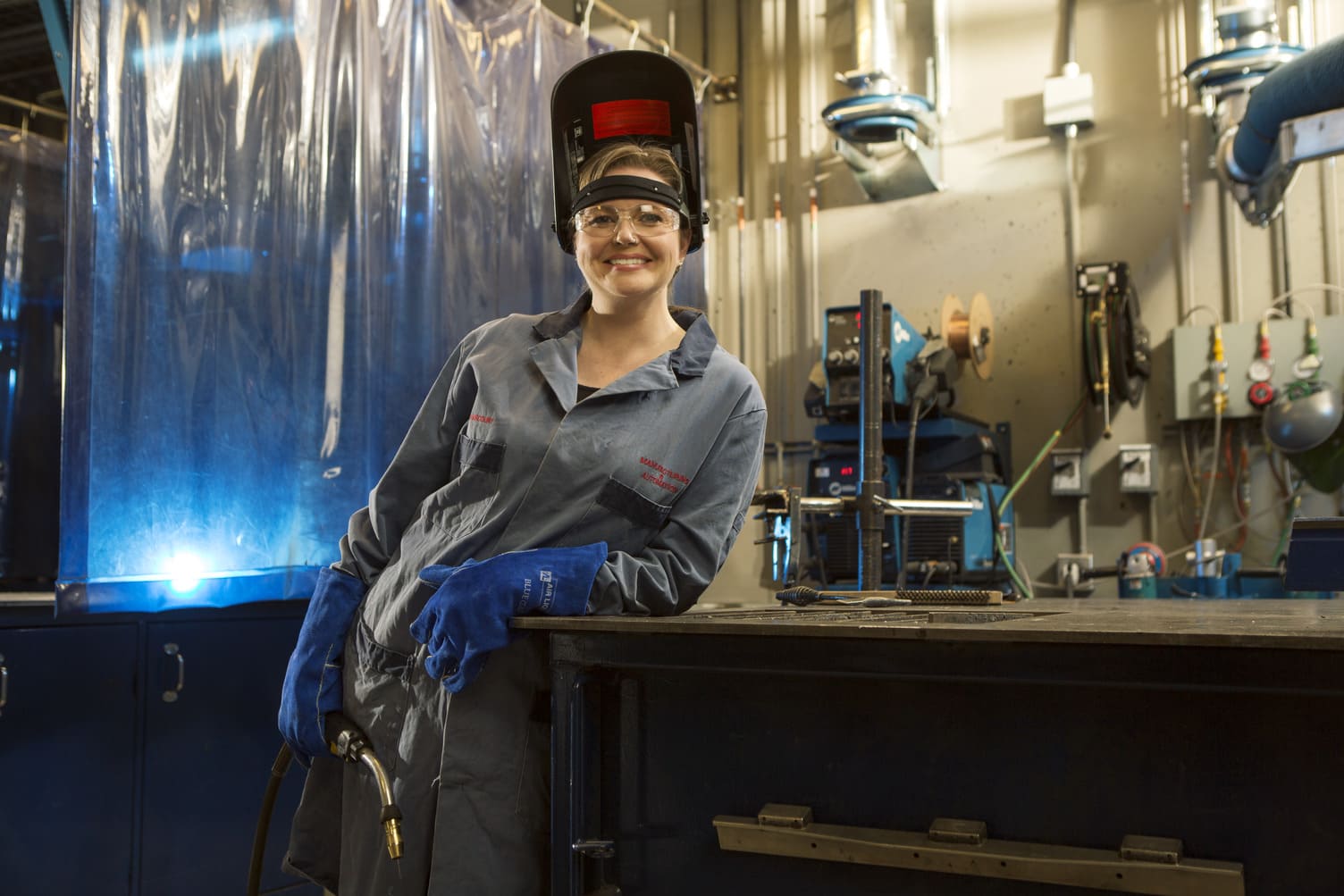On this page:
Overview
Learn how to set up and use precision metal cutting and grinding machines – such as lathes, milling machines, drills and grinders – to make and repair products made from metal, plastic, rubber, fibreglass and space-age alloys.
You’ll use logic and tools like micrometres and callipers to follow specific instructions and precise measurements. Some electronic instruments have digital readouts that you’ll program for use.
During a project, you’ll study specifications, charts, drawings or sample parts to determine what machining operation to perform. You’ll also calculate dimensions and prepare working sketches if needed. Additionally, you’ll measure and mark materials and set up and use tools – which may be computer numerically controlled – to verify dimensions, fit parts to mechanisms and perform machine operations.
Machinists are skilled tradespeople who are self-motivated and get excited about working on leading-edge machinery. If you’re creative and like working with precision, you’ll excel in this line of work.
To succeed in this trade, you should:
- have good hand dexterity and speed
- understand machinery
- have good problem-solving skills
- work precisely
- be able to accurately measure and estimate sizes and lengths
- be comfortable working independently on tasks that require high concentration and physical effort
- be committed to safe work habits.
Upon successfully completing the required working hours and technical training periods, you'll be awarded an advanced diploma in addition to journeyperson status by Alberta’s Apprenticeship and Industry Training.
This is a Red Seal Endorsed trade – a recognizable standard that allows tradespeople to work across Canada.
Careers and opportunities
Our graduates may work in the following occupations. Some careers require additional experience and education.
Associated National Occupational Classification (NOC) codes: 72100, 72010, 72101.
Apprenticeship training
The term of apprenticeship for a machinist is four years (four 12-month periods), including a minimum of 1,560 hours of on-the-job training and eight weeks of apprenticeship education each year.
Year 1 | Period 1
You'll learn about safety and measurements, machine tools, trade math and print reading.
Training length: 8 weeks
Year 2 | Period 2
You'll learn about metallurgy, heat treatment, tooling, machine tools, trade math and print reading.
Training length: 8 weeks
Year 3 | Period 3
You'll learn about computer numerical control machines (CNC), machine tools, trade math, computer-aided design and manufacturing.
Training length: 8 weeks
Year 4 | Period 4
You'll learn about computer numerical control machining centers, machine tools, computer-aided design and manufacturing, metrology, coaching and governance.
Training length: 8 weeks
Apprenticeship education performance
You must pass each section of the course and the AIT exam to succeed in apprenticeship education.
The passing grade for each period is no less than 50% in each course, with no less than a 65% average overall. A passing mark on each provincial exam and the interprovincial qualification (Red Seal Exam) is 70%.
View Alberta's Apprenticeship and Industry Training procedures
Training pathways
You can earn your journeyperson designation in the following ways.
The traditional training pathway begins with finding a job with an employer willing to indenture you as an apprentice. Once you are an apprentice, you will alternate between on-the-job training and educational periods.
You must apply for an apprenticeship through Alberta Apprenticeship and Industry Training before attending your first education period at SAIT.
SAIT’s two-year Machining Technology diploma program equips you with the necessary skills and knowledge to successfully challenge the Alberta Apprenticeship and Industry Training (AIT) exams for Machinist Periods one through four and the Journeyman apprenticeship exam.

Pre-employment pathway
SAIT’s Pre-employment Machinist program prepares you to enter into an apprenticeship with hands-on skills. Upon successfully completing the program, you’ll qualify to challenge the first-year Machinist apprenticeship exam.
Admission requirements
To enter an apprenticeship, you must have the educational qualifications required or recommended education for the trade to which you apply.
Entrance requirements are monitored and set by Alberta Apprenticeship and Industry Training.
Minimum requirements
Successful completion of the following courses:
- English 10-2
- Math 10-3
- Science 10
OR
A pass mark in all five Canadian General Educational Development (GED) tests
OR
Alberta Apprenticeship and Industry Training Entrance Exam
Recommended requirements
Apprentices with an Alberta High School Diploma that includes the following courses:
- English 30-2
- Math 30-3
- Physics 20 OR Chemistry 20 OR Science 20
- Related career and technology studies (CTS) courses

MyTradeSecrets
Once you have begun working as an apprentice, you can attend SAIT to complete your technical training.
You'll register for technical training at SAIT on MyTradeSecrets or you can register by phone.
Transfer agreements
At SAIT, we evaluate post-secondary credit you have previously earned and apply it to your SAIT credential. Explore our formal transfer agreements available for this program.
We can evaluate your prior education, even if we don't have a formal agreement in place.
Submit a transfer credit application
There are no formal transfer agreements currently in place for this program.
Transfer options for graduates
Build on the knowledge you’ve learned at SAIT. The opportunity to advance your education at an accredited post-secondary institution may be available.
🔗 Visit Transfer Alberta search tool for all transfer agreements in Alberta (including UCalgary, MRU and BVC).
If there are transfer agreements with other institutions outside of Alberta, nationally or internationally, they will be listed below.
Thompson Rivers University
- Program name
- Bachelor of Technology
- Available credits:
- 57
Thompson Rivers University
- Program name
- Bachelor of Technology: Trades and Technology Leadership
- Available credits:
- 60
Available intakes
Costs
2025/26 tuition and fees
The following costs are effective as of July 1, 2025.
This is a bring-your-own-device program with a standard computer hardware and software requirement. See the specific requirements on our computers and laptops page.
Books or modules, along with other items for classes, are approximately $600 per period.
We recommend you don't purchase books or modules ahead of time as they might be outdated by the time you attend classes, and they cannot be returned to the Bookstore.
Personal protective equipment (PPE) will be required for the program, which may be an additional cost to apprentices.

Funding options for apprentices
Apprentices get to learn while they earn, but there are still costs to consider. Many resources are available at SAIT and federally to help support apprentices.
Information sessions
Prepare for a strong start in your chosen program or get the details you need to decide your future path.
Our expert staff and faculty are ready to answer your questions and provide information about the following:
- What sets SAIT apart
- An introduction to the program and area of study
- Admission requirements
- Future career paths
- Information on the earning potential and graduate employment rates.
Contact
Have more questions?
Technical training at SAIT
School of Manufacturing and Automation
-
Phone - 403.284.8641
-
Email - ma.info@sait.ca
Apprenticeship training and registration
Apprenticeship and Industry Training Client Services

Oki, Âba wathtech, Danit'ada, Tawnshi, Hello.
SAIT is located on the traditional territories of the Niitsitapi (Blackfoot) and the people of Treaty 7 which includes the Siksika, the Piikani, the Kainai, the Tsuut’ina and the Îyârhe Nakoda of Bearspaw, Chiniki and Goodstoney.
We are situated in an area the Blackfoot tribes traditionally called Moh’kinsstis, where the Bow River meets the Elbow River. We now call it the city of Calgary, which is also home to the Métis Nation of Alberta.
